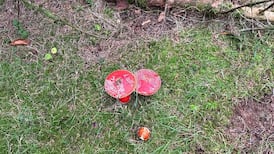ANOTHER LIFE:ONCE, WHEN YOUNG and snorkelling off a Greek island, I dived to snatch a little octopus from the seabed: the first, and indeed the only one, I have ever seen in the wild.
Left up on a jetty for closer inspection, it promptly ran across the slabs like a rubbery spider and leaped back into the sea, leaving me gaping. At least it didn’t cling on and nip me, with a toxic saliva brewed for paralysing crabs, or squirt ink into my face.
The late Prof Martin Wells of Cambridge, a celebrated student of the cephalopods, warned against such kidnap of any octopus bigger than a hand’s span across – “not because it intends you any harm, but because its immediate reaction when grasped is to hang onto everything within reach and clamp down”. Quite a small octopus, he declared, could hold a snorkeller underwater.
My first sight of any octopus was in Brighton, as a schoolboy. The town’s venerable aquarium, beside the pier, was still in postwar disrepair, its darkness dank and dripping, the glass walls fogged with algae. The resident octopus gazed out with a listless, prisoner’s eyes. The aquarium’s history, however, boasts an early and startling report of an octopus escapologist. In 1875, its aquarists were puzzled by the disappearance of their lumpfish until, early one morning, the neighbouring octopus was discovered in their tank. Reports of octopuses out of the water, roving at times between rock pools, have been current since Aristotle, but how long can they survive? Up to half an hour, says WikiAnswers; 10 minutes is nearer the truth.
Even today, Brighton’s aquarium puts extra weights on the lid of its current octopus, Betty, and its cephalopod researcher, Kerry Perkins, has great respect for octopus resourcefulness. She tells of one that objected to the light over its tank being left on at night and would squirt water to short-circuit it.
For that example, echoed by exploits viewable on YouTube, I am obliged to a recent New Scientistarticle by Caroline Williams, "A Beautiful Mind" (June 11th, 2011). If the latest analyses are to be believed, she concluded, the assembled skills of octopuses and their invertebrate ilk (squid, cuttlefish, nautilus) in navigating mazes, differentiating shapes, solving problems, learning from each other and so on "might show a rudimentary form of consciousness". Just how rudimentary bears on a new EU regulation on animal experiments, due to take effect in national laws by January 2013. For the first time, welfare provisions are extended to cephalopods, requiring ethical evaluation of experiments causing pain, distress or lasting harm.
Researchers will have to prove that no alternative method is practical, and weigh recommendations to use analgesics or anaesthesia to prevent possible pain. They will also have to justify taking animals from the wild.
Cephalopod scientists assembled for this April’s EuroCeph meeting at Naples were all for kindly provisions but worried what these could mean for their work. How does anaesthesia affect an octopus’s nervous system? Would flashing lights at cuttlefish, to see how they changed colour, be thought of as causing distress? For the next three years, EuroCeph will help researchers to develop guidelines to offer to their national regulators.
If Prof Wells had been at the conference (he died at 80, in 2009), his opinions would have been blunt. A big reason for studying cephalopods is that, in an evolution diverging from that of their fellow molluscs (broadly speaking, the snail family), their brain is concentrated in the head. It is split into two halves, like ours, connected by a bundle of nerve fibres, and then divided into further specialised lobes, some folded like the human brain, packed with neurons and with plenty of storage for memory.
“Practically every darn thing we know about how nerves work,” Wells said once, “has been worked out from squid nerves. That’s because squids have good, big nerves you can put electrodes into.” His early team experiments, testing octopus ability to distinguish, learn and remember shapes and patterns, involved repetition when the animals were blinded, or missing part of their brains.
Today's research varies widely, from chasing neuron links in living tissue (sometimes in slices in oxygenated salt water) to exploring the octopus's apparent individuality and sense of self. Many experiments employ the common European octopus, Octopus vulgaris,with its warty 70cm body and two rows of stout suckers on its tentacles, which is found off Ireland's south coast.
The usual species around our shore, however, is the smaller curled octopus, Eledone cirrhosa(in my drawing), some 50cm overall and with single rows of suckers. It lives among rocks and is occasionally stranded in rock pools at low tide – this much to the excitement of a Dún Laoghaire family, rock-pooling at Seapoint in spring of last year.
Today’s research varies from chasing neuron links in living tissue to exploring the octopus’s individuality and sense of self
Eye on nature
Last year I had some tadpoles that did not metamorphose into frogs. This year the spawn was a month later, and by the end of July the tadpoles were legless and armless. I'm afraid that there will be no frogs.Anne O'Reilly, Lucan, Co Dublin
Legs should be developed by eight weeks after spawning. Perhaps as spawn was a month late the development will also be late.
Starlings have monopolised our fat feeder, excluding other songbirds, and two of them have orange-yellow foreheads.Derry and B Cummins, Sandycove, Co Dublin
The songbirds may not be interested in fat at this time of year, when they are catching insects and caterpillars for their brood. The starlings have picked up pollen when catching insects in the flowers of New Zealand flax.
Why do spiders not get stuck on their webs?Philip Jacob, Glenageary, Co Dublin
Not all the strands of the web are sticky, and the spider knows which are not.
On a recent visit to Dublin, on Marlborough Road in Donnybrook at 11pm a large white bird appeared over the houses and swooped down on a small cat. Could this have been a barn owl?Enda Cogan, Brussels, Belgium
Yes, it could have been.
* Michael Viney welcomes observations at Thallabawn, Carrowniskey PO, Westport, Co Mayo, or e-mail viney@anu.ie. Please include a postal address










